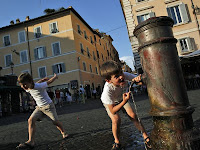Q&A - First Timers and Worldly Travelers
I’ve never been to Rome before, and I’m overwhelmed. Where do I start?
One of the best orientations to the city is a
stroll through the historical center, with its narrow streets and breathtaking vistas
of piazzas, fountains and ruins. But why not put your map away for two hours
and let one of our expert, local guides lead the way? Their explanations,
stories and helpful tips will make for a relaxing walk that will bring the city
to life, taking in not only the major sites of the city center but also a few
hidden gems easily missed by the casual tourist.
 |
| Campo di Fiori |
 |
| Pantheon |
Join our one of our Twilight Walks, which runs everyday except Mondays and Wednesdays at 5 or 6:00pm Adults 30 euro, students 25 euro.
For more details, visit our website www.romewalks.com.
I’ve seen the Colosseum, the Vatican, and the Pantheon and I want to see something besides Rome’s biggest tourist attractions. Where should I go?
It is practically impossible to run out of
fascinating things to do and see in the Eternal City. Rome Walks offers 10 group
walks and 19 private walks so that you can continue to discover different
facets of the city. You don’t have to be an art-buff to enjoy our For Art’s
Sake Walk, but you may end up becoming one after visiting some of the finest works
of Renaissance and Baroque art in the world with one of our art historians.
These masterpieces are not behind ropes in crowded museums, but are hidden
within the walls of quiet churches, each with its own unique and layered history
of papal patronage, religious significance and artistic and architectural treasures.
For Art’s Sake Walk, available on request (minimum 2 people) 3 hours. Adults 65 euro, students 45 euro. For more details or to browse our other walks, visit our website www.romewalks.com.














.jpg)

